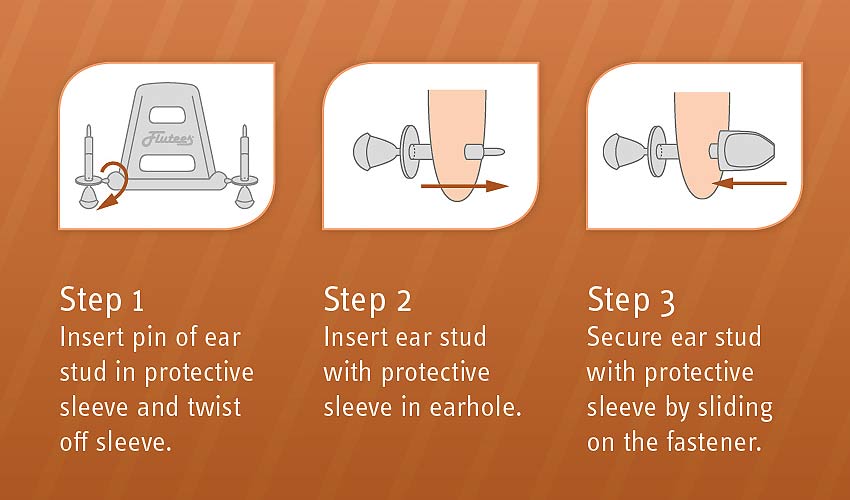- ACHETER
- Embouts de protection pour boucles d'oreille
- Application & Indications des embouts de protection
- Ultérieures informations
- FAQ
- Spécifications
Embouts de protection pour boucles d'oreille
- Le trou percé vous démange et brûle lorsque vous portez la plupart de vos clous d'oreille ?
- Vous ne pouvez pas porter des bijoux fantaisie en clous d'oreille parce que le trou percé s'infecte ?
- Les tiges de vos clous d'oreille en argent noircissent lorsque vous les portez ?
Le contact entre la peau et le métal, ou des impuretés sur votre bijou, peuvent en être la cause. Grâce aux Flutees®, le contact entre le trou percé dans l'oreille et la boucle d'oreille peut être efficacement évité, permettant ainsi de prévenir les réactions allergiques et les infections.
La peau au niveau du trou percé dans l'oreille est sensible et fine. Les Flutees protègent cette peau sensible contre les impuretés et préviennent tout contact avec le nickel, le cobalt, le cuivre, ou d'autres ions métalliques pouvant être à l'origine de réactions allergiques.
Les Flutees® sont fabriqués dans une matière plastique médicale de haute qualité. Ils sont produits et conditionnés selon des normes de qualité très rigoureuses en salle blanche. Chaque paire d'embouts, accompagnée des 2 fermoirs qui les complètent, est conditionnée de façon hygiénique sous plastique médical scellé. Chaque boîte de Flutees® contient 5 sachets avec, dans chacun d'eux, une paire d'embouts et leurs fermoirs. Changez votre paire des Flutees à chaque nouvelle utilisation.
- Protection contre les réactions allergiques liées au port de clous d'oreille
- Protection de la peau sensible
- Préviennent le changement de couleur dû au port des clous d'oreille
- Préservent la couche de platine des clous d'oreille platinées.
- Brevetés
- Fabriqués en salle blanche
- Fabriqués en Allemagne
25 paires




Application & Indications des embouts de protection
Mode d'emploiDétacherl'embout de protection de son support à l'aide de la tige de votre boucle d'oreille, en effectuant un mouvement de rotation. Introduisez ensuite la boucle d'oreille recouverte de son embout à travers le trou percé dans l'oreille, et maintenez en placela boucle d'oreille avec son embout à l'aide du fermoirqui l'accompagne.
Étape 1
Introduire la tige de la boucle d'oreille dans l'embout de protection et le détacher de son support par un mouvement de rotation.
Étape 2
Introduire la boucle d'oreille avec son emboutà travers le trou percé dans l'oreille.
Étape 3
Maintenir en place la boucle d'oreille avec son embout de protectionen insérant le fermoir à l'arrière.

Remarques
Le diamètre extérieur des Flutees correspond à peu près à un petit piercing. Cependant, ce faible diamètre est encore trop grand pour certains trous de percement d'oreille.
Veillez à ne pas « forcer » l'introduction des Flutee sà travers le trou percé dans l'oreille.
Il est fréquent qu'une « résistance » se produise, non pas lors de l'introduction à travers le trou percédans l'oreille, mais lors du retrait, au niveau de la sortie. Les utilisatrices et utilisateurs, dont les Flutees conviennent, peuvent les faire glisser d'une extrémité à l'autre à travers le trou percé dans l'oreille très aisément et sans difficulté.
Précautions à prendre
Les embouts de protection Fluteespour clous d'oreille (à tige droite)conviennent exclusivement à une utilisation avec ce type de clous d'oreille.Veillez à ne pas plier les embouts, et ne les utilisez pas avec des clous d'oreilleéquipées de crochets.
Pour des raisons d'hygiène, nous recommandons un usage unique des embouts de protection Flutees. Avec l'humidité et la graisse, le maintien du fermoirpeut s'avérer moins bon. Ceci se produit notamment en cas de réutilisationsmultiples. Les clous d'oreille ornées d'une parure lourde ou longue ne devront être utilisées qu'avec des Flutees dont l'emballage vient juste d'être ouvert, sinon le fermoirrisque de ne pas bien maintenir en place la boucle d'oreille.
Pour les personnes particulièrement sensibles, la parure de la boucle d'oreille ne devra pas dépasser de la rondelle de protection de l'embout. Sinon, il est possible que la zone du lobe qui n'est pas protégéesoit réactive au contact de la parure de la boucle d'oreille.
Ultérieures informations
Good to knowThe idea for developing Flutees protective sleeves was born out of the founder being personally affected by the discomforts, such as moist and burning ear holes, caused by wearing earrings. Therefore, the quality of Flutees protective sleeves has always been important to me.
The main objective of the development work was to generate a product of excellent quality, which fulfils the highest safety and security demands. The CE mark on our products confirm that we meet the requirements laid out in the provisions of the Medical Devices Act in accordance with Directive 93/42/EEC and that we have undergone a conformity assessment procedure to verify compliance with European standards.
Material
For the Flutees protective sleeves for ear studs, we use biocompatible material. As established by law, this, when coming into contact with living tissue, will not have any negative influence on the metabolism. Biocompatible material cannot be: toxic (poisonous), carcinogenic (cancer-causing), mutagenic (genotype altering) or sensitizing.
Design
Despite its slim texture the protective sleeve offers the highest possible stability. The production tool is designed in such a way that sharp edges on the front area of the sleeve cannot occur. Additionally, this area is rounded off. This method, along with a subsequent fine polish, guarantees a smooth and safe insertion of the sleeve into the ear hole. The “shielding plate” – the part of the sleeve that shields the earring stud from contact with the ear lobe – is not polished. This is the only way to achieve the matte transparent surface, ensuring that Flutees protective sleeves are almost invisible on skin. Finally, the question remains: how to deal with the “ridges”, the little sharp edges that can form around the “shielding plate” when the sleeves are first turned out of the Flutees clasp. We have cut the outer edge of the “shielding plate” in such a way, that a potential ridge will always point away from the skin of the ear lobe and there is no contact with the earlobe.
Production & Packaging
Not only material and design details affect the palatability and secure application of Flutees protective sleeves for ear studs; impeccable hygienic standards are just as relevant. Because of this, Flutees protective sleeves for ear studs are processed under clean room conditions, entailing an environment in which the amount of air particles is kept low with help of air pressure, airflow, relative humidity and room temperature.
The people working in the clean rooms wear special work clothes such as caps, gloves, breathing protection and even shoe covering. For industries such as pharmaceutical, medical and food production, the clean room has become indispensable. The same applies to Flutees protective sleeves for ear studs, which are not only packaged but even produced in this clean environment.
Nickel Allergy – Medical Aspect
Right after hayfever contact allergy is the most common allergy. Today over 3000 different contact allergens are listed. Nickel sulfide is thereby one of the most reactive.
Before the body reacts on nickel and shows symptoms such as an effected earlobe a sensitization takes place. Research tells that people wearing earrings and/or piercings are above‐average affected by nickel allergy. The EU issued the so-called Nickel Act to react to this circumstance. This Act refers to all jewelry pieces and limits the amount of nickel that a jewelry piece and therefore also an earring is allowed to release while wearing.
Since the introduction of the Nickel Act the amount of young people with nickel allergy declined. However, the rate of middle-aged and elderly persons with nickel allergy stayed the same. There are multiple reasons for this. On the one hand it could be possible that older nickel allergy sufferers have gained the allergy before the introduction of the Nickel Act. On the other hand it might also be possible that there is a correlation between the sensitization and the duration of the contact with the allergenic material. Doubtlessly, the Nickel Act reduced the amount of nickel in jewelry. Nevertheless, the body, when having much contact with nickel, is able to build antibodies against the allergenic material over time (sensitization). This possibly results in a nickel allergy at an advanced age.
Once the sensitization or contact allergy has emerged it usually stays for a lifetime since this form of allergy is a stable reaction of the immune system. Factors such as sweating, humidity and high temperature may foster the release of nickel. That might be the reason why earrings and piercings have a huge impact on the acquisition of a nickel allergy.
Until today there are no medical solutions to prevent nickel sensitization or to cure an already existing nickel allergy. The only solution is to avoid the contact with the allergenic material.
Due to the high impact of wearing earrings and piercings on the sensitization of nickel this particular prevention is of utmost importance.
Reactions such as infected, burning or itching earlobes do not only occur on people with nickel allergy but also on those without.
Responsible for this fact can be different metals. Cobalt for instance, that is used in many alloys is a common allergy trigger.
Also dirt or other impureness on the jewellery might cause skin irritation. This could be the reason why some people spontaneously react on a pair of earrings that they used to wear before without having any problems.
Often it is the case that only one of the earlobes becomes infected when wearing particular earrings.
Flutees protective sleeves for earrings not only help those with nickel allergy to wear the earrings they like but also prevent reactions with other metals or impurity.
Flutees protective sleeves for earrings are available in German pharmacies.
FAQ
Where can Flutees be found?Flutees can be bought via the Online-Shop as well as in pharmacies in Germany, Austria and Switzerland, see Tab "Flutees in Pharmacies".
How often can I use a pair of Flutees?
Flutees protective sleeves for ear studs are a product – like earrings – for which hygiene should play a significant role. We can only guarantee perfect hygiene of our product up to the date when the medical foil packaging is opened.
In addition, the sleeves have a delicate texture. Only users can judge whether, after multiple applications, the protective sleeves are still intact and still full fill their protective function. The same applies to the fasteners that begin losing their grip after multiple application due to fat- and humidity particles. For these reasons, we can only recommend onetime application, even if the sleeves are strong enough to use them several times. If you decide to use Flutees two or three times, please take them off at night and clean and control the product regularly.
Why do Flutees not fit into every ear hole?
The outer diameter of the Flutees protective sleeves for ears studs slightly exceeds the size of a commercial ear stud pin. Some ear holes are so narrow that the protective sleeves cannot be inserted in the injection canal despite their small outer diameter. A piercing can serve as guidance whether the Flutees protective sleeves will fit into an injection canal. The outer diameter of the Flutees protective sleeves is only 5 hundredths of a millimeter bigger than the diameter of the smallest standard piercing pin.
Why do Flutees not fit onto every ear stud?
Pins of ear studs are not standardized and are different in length and diameter. Additionally, some ear studs feature a distinct thickening between the jewellery part and the pin of the earring. In this case, since the sleeve is inflexible, it will not be possible to slide it up to the jewellery part, which means the ear stud will stick out from the ear lobe in an unbecoming way.
The inflexibility of the pin is also the reason why pins with a diameter larger than 0.9 mm cannot be covered by the protective sleeve. The protective sleeve would have to be able to widen to fit on a diameter exceeding 0.9 mm.
Why ae there no Flutees protective sleeves for earring hooks?
As the idea for developing the Flutees protective sleeves was born out of being personally affected and the piece of ear jewellery that induced the initial product development was an ear stud, the obvious first step was to develop protective sleeves for ear studs. Flexible protective sleeves to use with earring hooks are already in the pipeline.
Can i wear Flutees even with a plastic allergy?
No. Please refrain from using Flutees protective sleeves for ear studs if you have an allergy to plastic.
- Utilisation
- Au besoin
- Champ d'application
- Oreilles
- Groupe de produit
- Embouts
- Forme galénique
- Embouts
- Couleur
- transparent
- Marque
- Flutees®
- Domaine
- Allergie Nickel
- Contenu
- 25 Paire
- Garantie de Remboursement
- Non
 Deutsch
Deutsch
 English
English
 Français
Français





